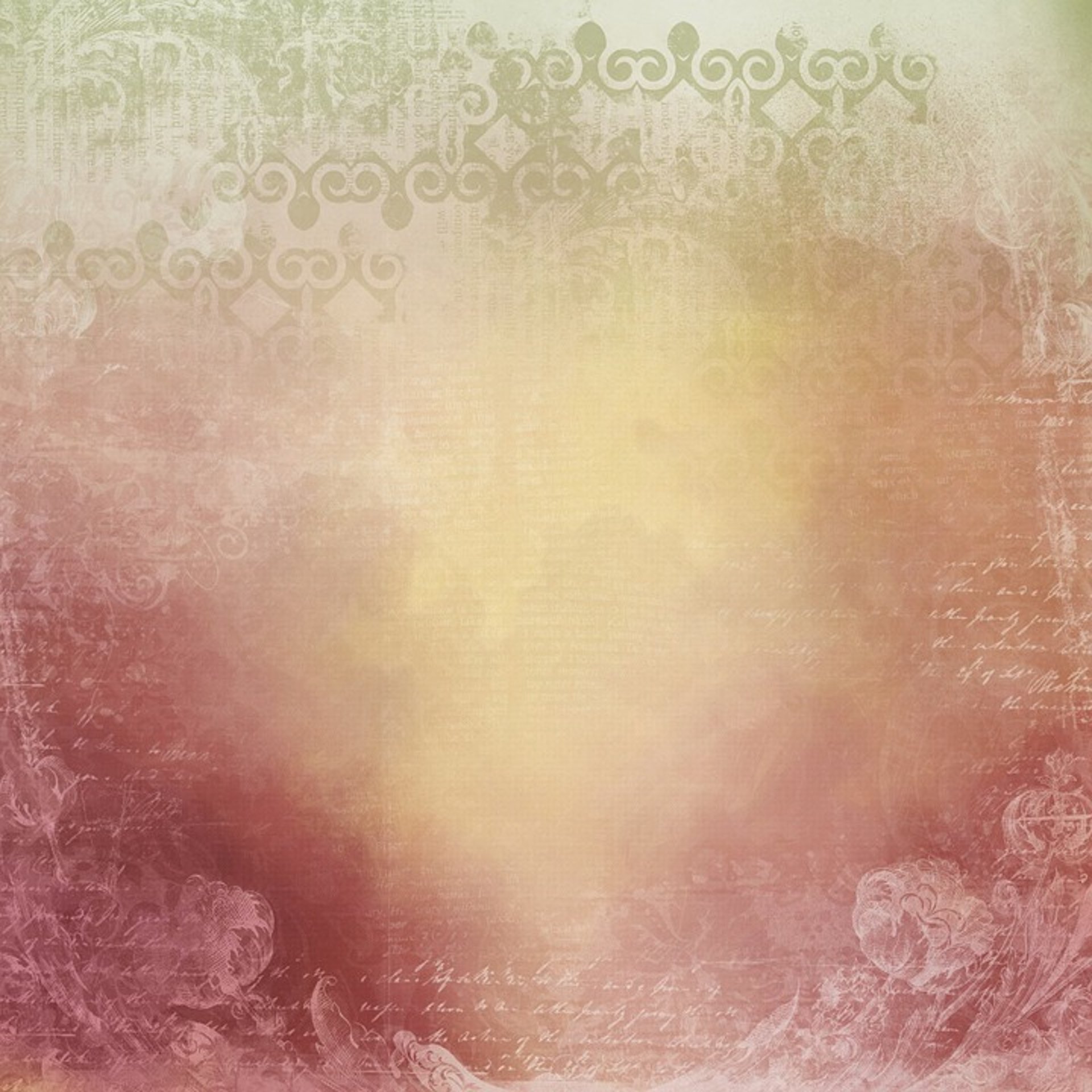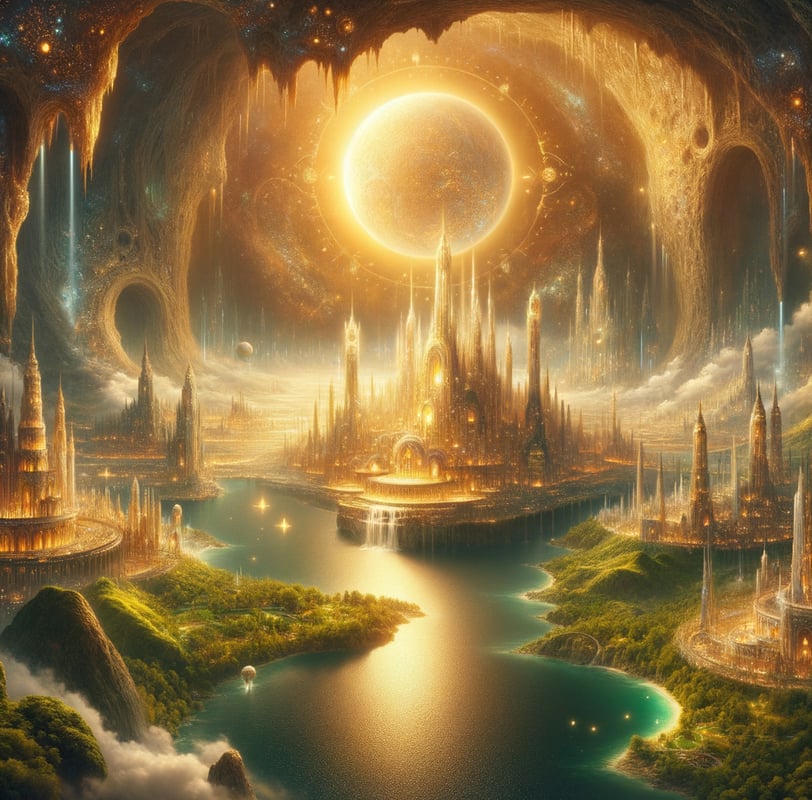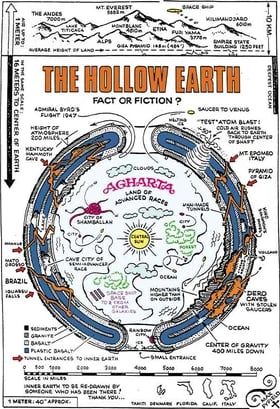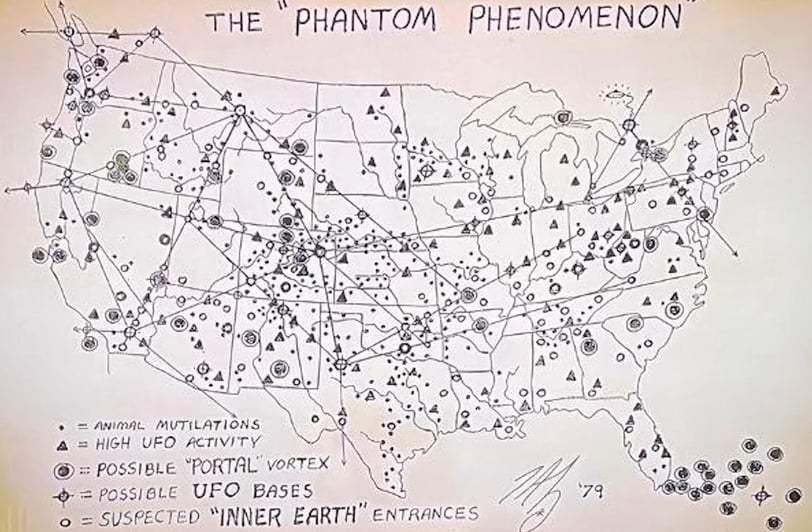Exploring Agartha
The Myth of Inner Earth and Its Mystical Connections
EARTH
Lily
3/26/20259 min read



Introduction to Agartha
Agartha, often referred to as a legendary utopia, is a mythological world believed to lie within the Earth's core. This concept captures the imagination of many and has intrigued scholars, writers, and explorers for centuries. The myth of Agartha signifies more than just a hidden civilization; it embodies a profound connection to various cultural beliefs and mythologies that span across multiple civilizations throughout history.
The origins of the Agartha legend can be traced back to ancient texts and teachings, with many attributing its inception to Buddhist teachings. Further popularization of Agartha occurred in the late 19th and early 20th centuries when the notion of subterranean worlds found traction in Western esotericism. This preservation of the myth in popular culture owes much to authors like Jules Verne and Helena Blavatsky, who depicted inner earth implications in their works. In their narratives, the idea of an advanced civilization residing in the depths of the Earth ignites curiosity about what life might encompass beneath our feet.
The portrayal of Agartha varies widely among cultures, with some depicting it as a place rich with wisdom and enlightenment, while others render it a land inhabited by fabulous beings and mythical creatures. As a result, this elusive city continues to be a source of wonder and debate, prompting individuals to explore what lies beneath the Earth's surface. The influential nature of the Agartha myth extends to modern-day interpretations, where it intersects with contemporary ideas about spirituality, environmental concerns, and otherworldly experiences.
In summary, the legend of Agartha serves as a testament to humanity's fascination with what lies beyond the tangible world. As cultures weave their interpretations into the narrative, it invites ongoing exploration of the mysteries that dwell deep within our planet, making it a captivating subject worthy of exploration.




The Inner Earth Myth: Myths and Legends
The concept of an inner Earth, a world existing beneath our feet, has fascinated cultures around the globe throughout history. Myths and legends of subterranean realms are emblematic of humanity's enduring curiosity about what lies beyond the visible surface of our world. Ancient civilizations, from the Greeks to Native American tribes, have shared compelling narratives that delve into this mystical frontier.
In ancient Greek mythology, the concept of the underworld was vividly depicted in texts such as Homer's "Odyssey." Here, the heroic figure Odysseus descends to Hades, a realm governed by the god of the dead, where the souls of the departed dwell. This portrayal of a hidden world beneath the Earth not only reflects the Greeks' understanding of life and death but also signifies humanity's desire to make sense of existence beyond the tangible.
Similarly, in Hindu texts, such as the "Mahabharata" and "Puranas," there are references to the "Patala," a subterranean region inhabited by serpents and other mystical beings. This idea suggests that the inner Earth is not merely a void, but a vibrant, populated realm with its own unique life forms and societies. The Hindus viewed Patala as a realm of both danger and treasure, serving as a testament to the duality of ancient human beliefs regarding the world beneath us.
Native American folklore is replete with tales of underground civilizations. Many tribes, including the Hopi and Navajo, speak of "the people of the inner Earth," sometimes referred to as the "ant people." This mythology embodies a profound respect for nature and often conveys messages about harmony and balance. Such legends are indicative of how deep-rooted the notion of an inner world is across diverse cultures and historical epochs.
The rich tapestry of stories surrounding the inner Earth myth highlights the universal human inclination to explore and understand the unknown. Whether through allegorical tales or religious texts, these narratives reflect a persistent intrigue with what lies beneath the surface, a theme that continues to inspire curiosity in modern times.
Pathways to Agartha: Openings and Entrances
The myth of Agartha, an enchanting realm said to exist within the Earth, is associated with various reputed entrances scattered across the globe. These so-called pathways to Agartha have captured the imagination of explorers, spiritual seekers, and enthusiasts of esoteric traditions. Each location is steeped in its own unique lore, creating a rich tapestry of myths surrounding this hidden world.
One of the most prominent entrances that enthusiasts believe leads to Agartha is situated at the North Pole. Legend asserts that beneath the icy expanse lies a vast network of caverns inhabited by advanced beings. This idea has been fueled by the claims of early explorers who spoke of experiencing peculiar phenomena and unusual sightings in this frozen wilderness. In contrast, the South Pole also features prominently in these narratives, with reports suggesting secret tunnels and access points leading directly to the fabled inner Earth.
On the American continent, Mount Shasta in California is frequently cited as a significant entrance to Agartha. This majestic mountain has long held spiritual significance for many Native American tribes, and it continues to be a center for mystical activities. Followers of various spiritual paths have reported encounters with ethereal beings and experiences that deepen their connection with the energies believed to emanate from the Earth’s core.
Other notable sites include the Himalayas, where some contend that the legendary city of Shambhala acts as a gateway to Agartha. Additionally, the depths of certain caves and caverns have drawn interest, with explorations revealing formations and features that seem to transcend the ordinary. Various legends also suggest that meditation and heightened states of consciousness might offer means to access these hidden realms, allowing seekers to bridge the gap between worlds. These methods promote an exploration not just of physical spaces, but of spiritual dimensions, intertwining the myth of Agartha with human intuition and experience.
Dangers of Seeking Agartha: Risks and Challenges
The legend of Agartha, a mythical realm believed to be located within the Earth's crust, has drawn the interest of explorers, adventurers, and curious minds alike. However, the pursuit of this inner earth paradise is fraught with considerable dangers and challenges that can have dire consequences for those who embark on this quest. From physical hazards to psychological risks, the journey toward discovering Agartha can lead to life-altering outcomes.
Physically, seekers of Agartha often face treacherous terrain that includes steep mountains, deep caverns, and shifting landscapes. Many of the rumored entrances to this hidden world are said to be located in remote and inhospitable areas, making the journey not only strenuous but perilous. Harsh weather conditions, which can range from extreme heat to freezing cold, further complicate the expedition. Such environmental obstacles increase the risk of injuries, exhaustion, and even fatal accidents. Adventure seekers must be adequately prepared and equipped, as their physical fitness and survival skills are put to the test throughout their journey.
On a psychological level, the allure of Agartha can lead individuals into a state of obsession, where the line between reality and fantasy becomes blurred. Some individuals may become so fixated on the quest for inner earth that they abandon personal responsibilities and social connections, causing profound emotional and mental strain. Delusions regarding their ability to reach Agartha can lead to risky decisions, including reckless adventuring into unsafe environments without proper preparation. History has shown that many explorers who have become consumed by the myth of Agartha have faced tragic outcomes, serving as cautionary tales for future adventurers.
In summary, while the myth of Agartha captivates the imagination, it is essential to acknowledge the significant risks involved in seeking this legendary land. Potential physical dangers combined with psychological challenges should remind aspirants that some journeys are best undertaken with caution and a realistic understanding of the possible consequences.
Agartha Through History: Noteworthy Accounts
The concept of Agartha, often described as a mythical city located within the Earth, has been referenced throughout various historical accounts and literature. Its origins can be traced back to ancient traditions, where it was often associated with utopian ideals and spiritual enlightenment. One of the earliest mentions of such underground civilizations can be found in ancient Indian texts, which speak of the "Siddhashrama," a hidden realm inhabited by wise sages.
In the late 19th and early 20th centuries, the notion of Agartha gained renewed interest through the works of explorers and writers who sought to uncover the mysteries of the Earth. Notably, the French author and occultist, Jacques Bergier, along with his colleague, Louis Pauwels, significantly popularized the legend in their book, "Le Matin des Magiciens" (The Morning of the Magicians). They proposed theories that linked Agartha to the lost city of Atlantis and posited that access to this hidden realm could be achieved through polar entrances. Bergier and Pauwels’ work interweaved scientific inquiry with fantasy, captivating the imagination of many seekers of the unknown.
Additionally, explorers like Milton Cooper and Richard Byrd expanded upon the Agartha narrative, claiming they had encountered evidence of a subterranean world during their expeditions. Byrd's supposed journey to the North Pole, where he was said to have witnessed strange phenomena and beings, further fueled the mystique surrounding Agartha. These accounts, although often met with skepticism, contributed to a growing body of literature that portrayed Agartha as not only a physical location but also a significant spiritual and philosophical realm.
Throughout the years, Agartha has served as a symbol of humanity's quest for knowledge, representing ideals of peace and wisdom accessible through inner exploration. As such, its ideology has transcended mere myth, becoming a significant aspect of esoteric thought and attracting a diverse audience curious about the mysteries of the Earth and beyond.
General Byrd's Flight: The Antarctic Expedition
Admiral Richard Byrd is renowned for his pioneering efforts in polar exploration, particularly his expeditions to Antarctica during the early to mid-20th century. In 1928, Byrd led his first significant expedition to the Antarctic, with the intention of conducting scientific research and mapping the region. His subsequent missions, especially the Operation Highjump in 1946-1947, later became subjects of fascination, particularly among those interested in the concept of Agartha, the mythical inner Earth realm. Reports emerged that some of Byrd's flights had led him to peculiar observations, asserting that he discovered vast, uncharted territories beyond the known limits of Antarctica.
One notable element that would contribute to the ongoing intrigue surrounding Byrd is his reported flight over the South Pole, during which he claimed to have spotted lush landscapes that contradicted the harsh and icy environment typically associated with Antarctica. This peculiarity sparked speculation that such hidden valleys and warm climates could indeed connect to the legendary world of Agartha. Byrd’s suggestions of encountering advanced civilizations or thriving life underground fueled numerous conspiracy theories linking his expeditions to the belief in a hollow Earth.
The interest in Byrd's Antarctic journeys was further amplified by the enigmatic nature of several of his journal entries, which hinted at discoveries that could redefine humanity’s understanding of geography and history. Initially, these entries were dismissed as fantastical, primarily due to the operations' military context, yet they resonated with those who had long believed in the existence of an inner Earth. The combination of Byrd's esteemed reputation as an explorer and his reportedly strange findings left many curious about whether there might indeed be a hidden realm waiting to be uncovered beneath the icy surface of the polar regions. As such, his expeditions are often cited in discussions regarding Agartha, igniting questions about what lies beneath the Antarctic ice.
Agartha and the Occult: Rituals and Witchcraft
Agartha, often regarded as a hidden city beneath the Earth's surface, has fascinated spiritual seekers and esoteric practitioners alike. Various traditions link this inner realm with occult practices, suggesting that it is a source of profound power and magic. The belief in Agartha intertwines with witchcraft, where ancient practices are thought to create pathways to its enigmatic inhabitants.
Throughout history, many cultures have viewed the inner Earth as a sacred space, housing beings with immense wisdom and spiritual abilities. In several occult traditions, rituals aimed at establishing contact with these inhabitants of Agartha are performed, with the belief that such connections could enable the practitioner to harness unique energies and insights. For instance, some practitioners believe that specific meditative practices, enhanced by herbal preparation or the use of crystals, can facilitate communication with beings from Agartha.
The connection between Agartha and witchcraft is not confined to historical texts but has been perpetuated through modern interpretations as well. Contemporary occultists often incorporate rituals inspired by described practices intended to bridge the earthly realm with that of Agartha. This includes ceremonial gatherings, where participants may invoke energies associated with the inner world in hopes of receiving guidance or enlightenment. Furthermore, interpretations of ancient symbols and archetypes associated with Agartha play a vital role in shaping these modern witchcraft practices. Rituals may involve invoking deities, drawing sigils, or engaging in trance-like states to enhance the practitioner's connection to this mystical world.
As we explore the intricate relationship between Agartha and the occult, it becomes evident that different traditions perceive this inner realm as not merely a fantasy but a repository of ancient wisdom and powers that continue to inspire and influence contemporary spiritual practices.

Suggested viewing on YouTube.
Magick
Explore the enchanting realm of Witchcraft today.
©Lilyopatra 2025. All rights reserved.
All SALES ARE FINAL, and we appreciate your understanding of our site policy. Once a purchase is made, we cannot offer refunds or exchanges for any items. This policy ensures that we can maintain low prices and high-quality products for our customers. We encourage you to thoroughly review product descriptions, sizes, and specifications before completing your purchase to avoid any dissatisfaction. If you have any questions about an item, please reach out to our customer service team prior to ordering. We value your business and are committed to providing a positive shopping experience, but once a transaction is finalized, we are unable to accommodate any changes or returns.
Thank you for your cooperation and support.

